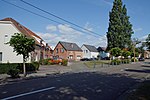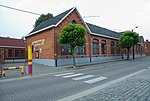Mol (Dutch pronunciation: [mɔl] (listen)) is a municipality located in the Belgian province of Antwerp. The municipality only comprises the town of Mol. In 2021, Mol had a total population of 37,021 inhabitants. The total area is 114.19 km2.
Mol is a popular holiday resort, with many lakes surrounded by woods. There are two main tourist lakes:
Zilvermeer, which opened as a Provincial Park in 1959 and offers a white sand beach as well as facilities such as an outdoor playground and an underwater museum for divers.
Zilverstrand: Originally, it had only an outdoor lake with a white sand beach. Later, a caravan park was built and mid-1990s an indoor swimming pool was created.Furthermore, there is a Sun Parks holiday centre called "Kempense Meren" with an indoor swimming pool. The museum of Jakob Smits is located in the former vicarage of Mol-Sluis. This displays works of the artist Jakob Smits (1855-1928) and other painters of the Molse School, who were attracted to the area by its rustic views including several windmills (of which only one remains).
In the north-east corner of Mol, near the Dutch border, lies the Norbertine Postel Abbey. Mol is also home to the SCK•CEN Belgian Nuclear Research Centre, the Flemish institute for technological research (VITO) and a European School. The first industries in Mol were the Vieille Montagne company and the explosive factory N.V. La Forcite. In 1872 the Sablières et Carrières Réunies (SCR), now Sibelco, was founded in order to extract the silica sand layers in Mol for industrial applications. The company became the global market leader in this sector with production sites all over the world.
The 15 chapels were built by Pater Helsen in 1815 with 14 co-workers of the region. It is a protected monument.











